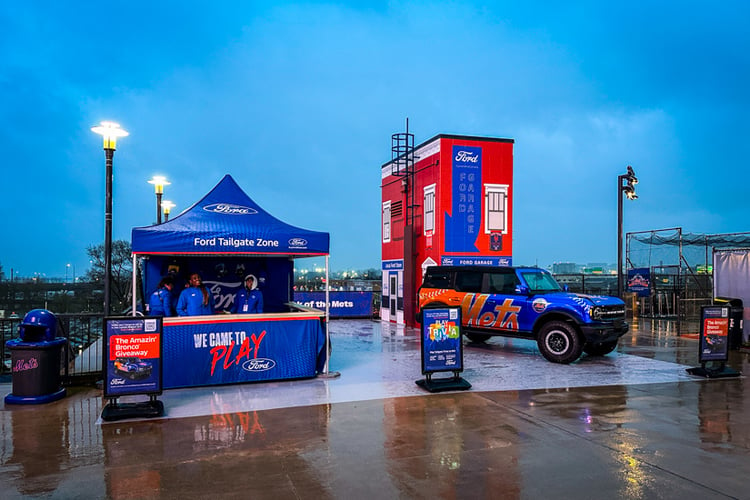
5 Best Pop Up Canopy Tents for Heavy Winds & Rain
There’s a reoccurring question from MANY people who reach out to TentCraft looking for a new custom pop-up canopy tent:
“How well does your pop-up tent stand up to heavy winds?”
It’s a fair question. Those who are in the market for a professional canopy tent invest thousands of dollars into a solution and they need to know it’s going to handle unpredictable wind and rain.
(You'd also like something that's truly battle tested — like the MONARCHTENT in this video!)
Often, these customers have experienced a cheaper pop-up tent model and know they need to upgrade. They also can’t afford to misrepresent their brand — and need something with professional, lasting quality.
Frankly, it’s overwhelming to research and compare different heavy-duty pop-up tents. A quick Google search for “best pop-up canopy tents for wind” returns a bevy of different results from companies solely pushing their own tents (even if their tents aren’t the best on the market) to publishers hoping for clicks to their Amazon affiliate links to earn a commission.
At TentCraft, we’re most concerned about finding the best fit and not forcing a customer into a solution that may not be the best for them. In other words, we’re not afraid to recommend products from our competitors.
In fact, we’re occasionally asked, “If we don’t use TentCraft… who would you recommend?”
And we don’t hesitate to recommend a handful of competitor products and companies.
We back up those recommendations with nearly 20 years of experience in this industry. As the only U.S. manufacturer of heavy-duty pop-up tents (all other brands import their frames overseas, mostly from China), we have a team of expert engineers, metal fabricators, and project managers who understand every little facet of a pop-up tent, and who can explain what truly makes it heavy duty enough to stand up to 40 mph winds.
So, we’ll introduce you to our heavy-duty pop-up tent, MONARCHTENT, in addition to highlighting our recommendations for the best pop-up tents for heavy winds and rain. Following those recommendations, we’ll teach you what really makes a pop-up tent heavy duty and what to look for when shopping for a new tent.
The Best Pop-Up Canopy Tents for Wind & Rain
To keep reviews consistent, all pop-up tents mentioned in this list are based on a 10x10, standard peak model.
Important: Various custom canopy companies tout their tents can handle 60-70 mph winds when properly tied down. That may be true, but you should NEVER keep your pop-up tent in those types of dangerous winds. Hurricane force winds start at 70 mph — and if you’re outside with your tent in that type of weather, you have MUCH bigger problems to deal with than wondering if your pop-up tent will survive a storm.
TentCraft MONARCHTENT

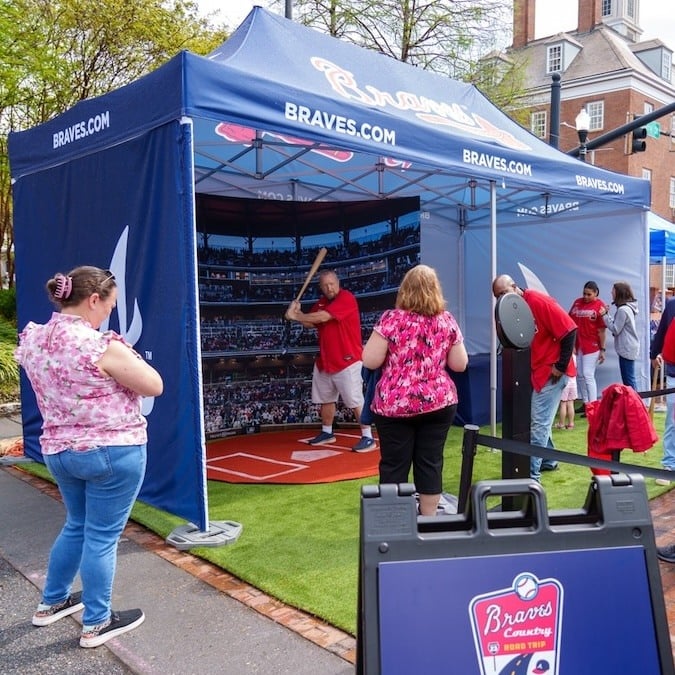
-
Frame Warranty: Lifetime
-
Anodized Aluminum Frame & Joints
-
2” Leg Diameter with Octogonal Profile
-
2 mm Aluminum Wall Thickness
-
Frame Weight: 75 lbs
-
Heavy-Duty Cast Aluminum Footpads
How does it handle wind and rain?
MONARCHTENT comes with a certified wind rating of 35 mph when properly ballasted. It’s the only pop-up tent to come with a certified wind rating from a professional engineering firm. In terms of rain, the canopy is made of a proprietary material called Duranti — a 600D polyester material specifically made with a higher tensile strength to prevent water pooling.
MONARCHTENT is the result of our knowledge of pop-up tents and what makes them indestructible. As the only tent on this list that’s 100% made in the USA, we take great pride in the craftsmanship and quality that goes into every MONARCHTENT.
It checks all of the boxes of a heavy-duty tent and some. One of the biggest differentiators is the heavy-duty footpad made of cast aluminum. We understand vendors and exhibitors drag their tents across hard surfaces and need a reliable foundation every time they set up their tent.
MONARCHTENT is one of the more expensive options on this list, starting at $2,999 for a 10x10 model fully printed. We back up our American quality, though, with a lifetime frame warranty.
Mastertent S1
-
Frame Warranty: 5 years
-
Anodized Aluminum Frame & Joints
-
2” Leg Diameter with Octagonal Profile
-
2.5 mm aluminum wall thickness
-
Frame Weight - 70 lbs (10x10 model)
-
Stainless Steel Footpads
How does it handle wind and rain?
The Mastertent S1 doesn’t come with a certified wind rating, but the company has tested it in a controlled wind tunnel at wind speeds of 60 mph. The company offers “automatic awnings” to extend coverage from rain.
We used to sell Mastertent frames, so we’ve had first-hand experience with the frame and can attest to its quality.
Mastertent shows the strength of its pop-up tents with videos of the product in a controlled wind tunnel environment with wind speeds reaching 75 mph. That number is impressive, but it’s important to know a wind tunnel test doesn’t mimic real-world wind, which blows at unpredictable speed and direction.
Still, the Mastertent S1 model checks all of the boxes of a heavy-duty pop-up tent. It features an all aluminum frame, a 2” leg diameter with 2.5mm aluminum walls, and a frame weight of about 70 lbs., which is ideal for a commercial-grade pop-up tent.
We’d like to see a thicker footpad on the S1, which features stainless steel footings.
PDG Gorilla Max
-
Frame Warranty: 10 years
-
Anodized Aluminum Frame & Joints
-
2” Leg Diameter with Octagonal Profile
-
1.6 mm aluminum wall thickness
-
Frame Weight - 65 lbs (10x10 model)
-
Thinner Aluminum Footpads
How does it handle wind and rain?
The company doesn’t advertise about how it handles wind and rain, but the frame weight should be heavy enough to handle reasonable wind when properly ballasted.
Promotional Design Group is best known for their custom-printed inflatables. Check out their gallery for some really incredible custom inflatable props and structures. They also offer four pop-up tent models — the heavy duty model is called the Gorilla Max.
While it uses a thinner aluminum profile (which does make transportation a little easier!). The company offers a 10-year warranty, which makes it more appealing than Ins’tent and Mastertent offerings.
Ins’tent V3
-
Frame Warranty: 5 years
-
Anodized Aluminum Frame
-
Fiberglass Connection Joints
-
2” Leg Diameter with Octagonal Profile
-
2 mm aluminum wall thickness
-
Frame Weight - 50 lbs (10x10 model)
-
Steel Footpads
How does it handle wind and rain?
Ins’tent tested its V3 in a wind tunnel and showed the tent could withstand 60 mph winds. Remember: wind tunnel tests are highly controlled and don’t replicate real-world wind, which swirls in all directions.
Ins’Tent is the US-based arm of Vitabri and is located in Huntington Beach, California. Vitabri is based in France, where it has manufactured pop-up canopies for more than 20 years.
The company’s V3 tent doesn’t feature an all-aluminum frame because the connection joints are made of fiberglass (which is still stronger than plastic). Still, it comes in at a lower price point (about $1,300) than some of the other tents mentioned in this article.
ExtremeCanopy Q8 Quasar
-
Frame Warranty: 10 years
-
Anodized Aluminum Frame & Connection Joints
-
2” Leg Diameter with Hexagonal Profile
-
2 mm aluminum wall thickness
-
Frame Weight - 56 lbs (10x10 model)
-
Steel Footpads
How does it handle wind and rain?
ExtremeCanopy describes its heavy-duty tent as “wind resistant,” which doesn’t commit to an actual wind rating. They promoted a test they ran where they pulled the tent behind an SUV driving 70 mph, but that doesn’t mimic actual wind.
Extreme manufactures its tent frames in China and distributes around the globe.
The Q8 is its heavy-duty offering that features an all-aluminum frame and roof tensioning system. It is on the lighter side at 56 lbs.
What separates this tent apart from the competition is the four groove channels that can be used to attach slide-in keder walls or half-walls.
Buyers Guide: What Makes a Pop-Up Canopy Tent Heavy Duty?
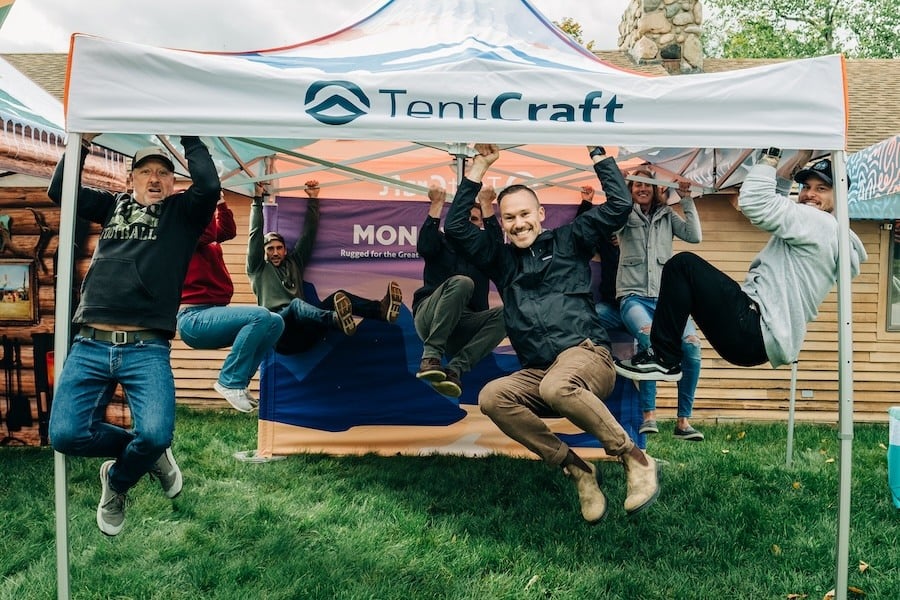
To find the best pop-up tent for use in unpredictable wind and rain, you first need to understand what exactly makes a pop-up tent heavy duty.
As the only USA-based custom tent manufacturers, we have a strong understanding of not only the marketplace but also the engineering and materials used in pop-up tent manufacturing. This is important for you because you’re going to see a lot of marketing lingo around some tents being the “strongest pop-up canopy tent in the industry!”
But without proof or a baseline understanding of what actually determines strength and durability, that type of marketing is an empty statement.
So, here’s what classifies a pop-up tent as heavy duty:
Breaking Down a Heavy-Duty Pop-Up Tent
The following video walks you through what truly makes a pop-up tent heavy duty.
Material: Anodized Aluminum
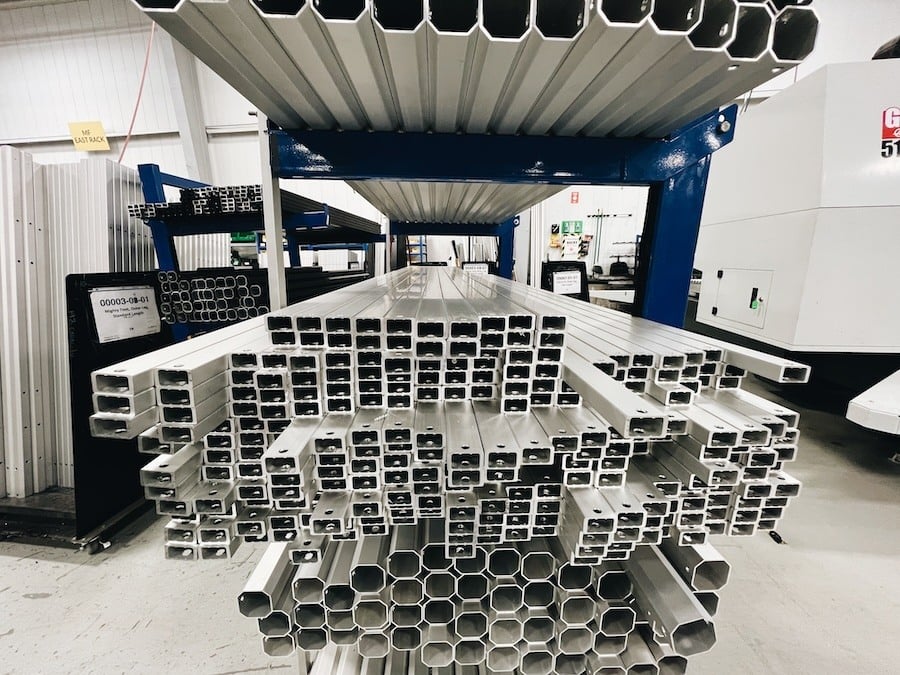
The first thing to look for is an aluminum frame — specifically anodized aluminum. This is a must-have to be classified as a heavy duty.
When aluminum is anodized, the natural oxide layer on the surface is increased, resulting in a new layer that is 100 times as thick and nearly as hard as a diamond. Anodized aluminum is also corrosion resistant, whereas steel frames chip, crack and rust.
The biggest advantage of aluminum is in its strength-to-weight ratio. Since aluminum is approximately one-third the weight of steel, more of it can be used in the frame design to increase strength and durability.
All of the tents reviewed above are made using aluminum frames. If you need something heavy-duty to use in wind and rain, don’t even bother buying a steel-frame tent.
Aluminum Thickness (Gauge)

Material thickness — or gauge — is also important.
Commercial pop-up canopy tents need a wall thickness of nearly 2mm (12 gauge aluminum). A pop up tent with a material thickness of 1mm is built more for recreational use (think backyard barbecues) and isn’t going to deliver the durability or product life that a commercial grade pop up tent does.
Leg Design & Diameter
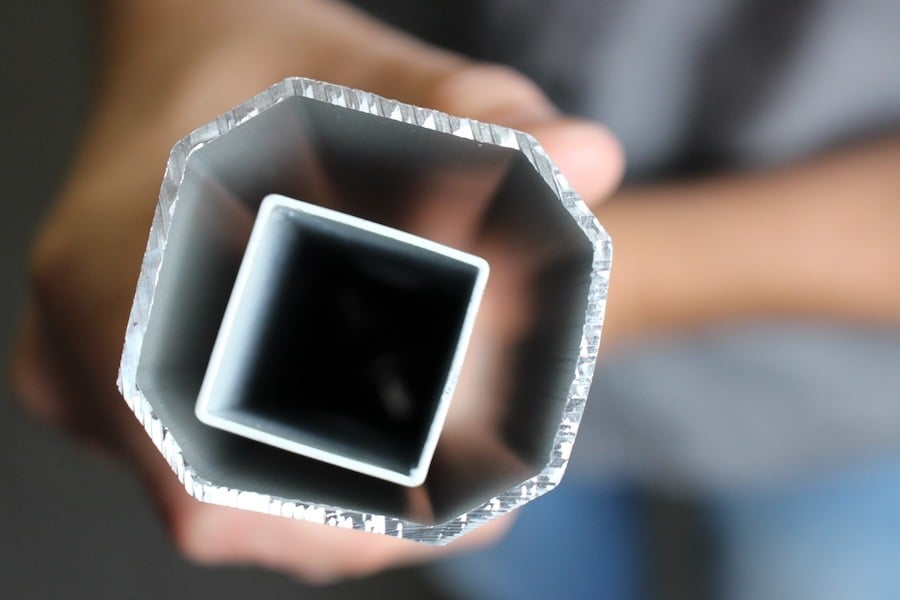
The total leg diameter is also an important factor. Heavy duty pop up tent models have a leg diameter of 2” or 50mm.
You’ll also find that pop up tent models are available in square, hex and octagonal leg profiles. The purpose of a hex or octagonal leg design is that it’s not only easier to grip but also adds more surface area to the base of the leg, creating greater balance and stability. (This is only the case if the diameter of a hexagon or octagonal leg is larger than the square leg.)
Connecting Joints
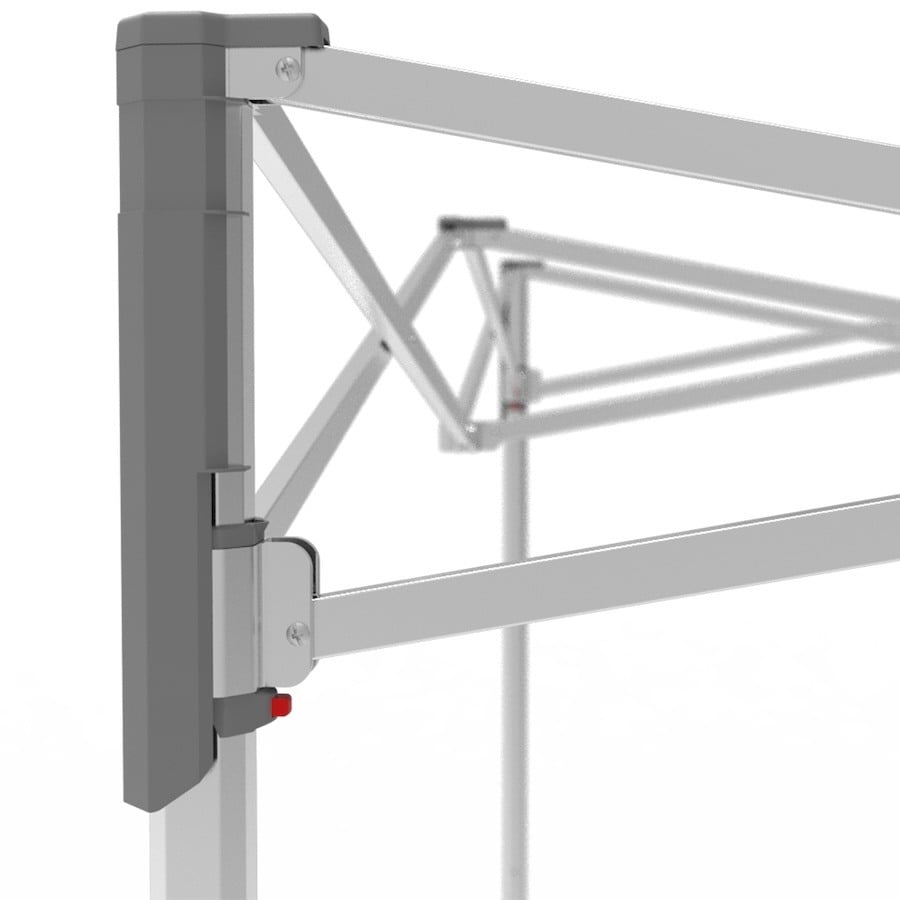
All recreational-grade pop-up tents use plastic connector joints, while more professional, heavy-duty solutions use aluminum joints. Just like the joints on your body, these areas bear a lot of weight and friction.
For true durability, a heavy-duty tent needs to be manufactured with anodized aluminum joints.
Footpad Design

The footpad (or pop up tent feet) is an often overlooked feature of pop up tent design. This kind of bothers us because the footpads carry the weight of the frame, get dragged across hard surfaces and are the first part to make contact with the ground when unloaded--or even dropped off the bed of a truck.
The unexpected can and will happen. Damage to just one foot can render your entire tent useless.
Cheaper pop up tent models use a steel or aluminum plate that is closer to ⅛” thick, while a commercial-grade pop up canopy will have a thicker footpad--closer to ¼”--that is usually made from cast aluminum.
Frame Weight
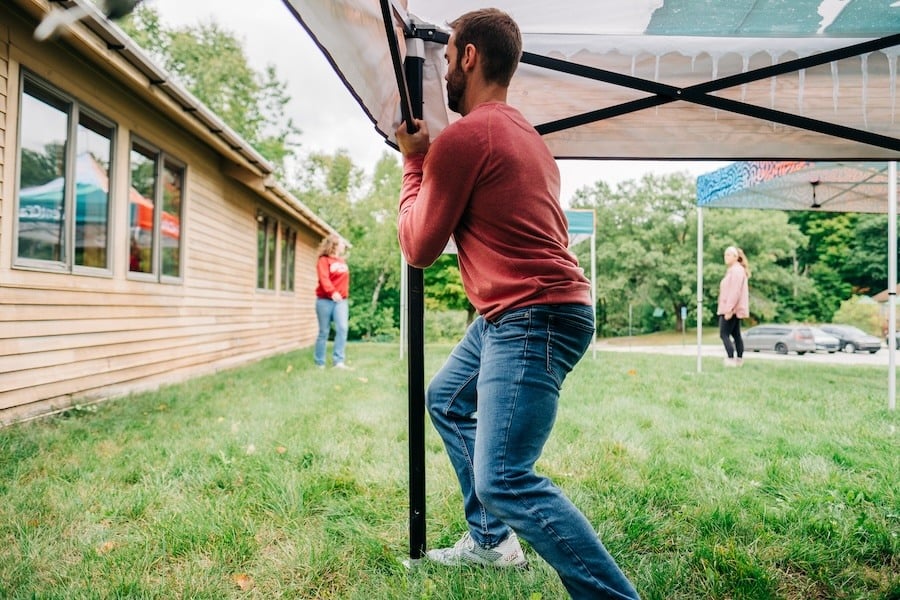
Since heavy duty aluminum pop up frames use more material, it should be no surprise they weigh more. Steel pop-up tents would weigh even more — 3X more! — if they were made with the same amount of material as aluminum tents.
The overall frame weight is a good indicator of whether or not a tent is heavy duty. A 10x10 model should typically fall in the 60-70 pound range.
Tents under 60 lbs are easier to transport, but may not stand up to wind as well.
Heavy-Duty Pop-Up Tent FAQs
How much does a heavy-duty pop-up tent cost?
You can expect to pay at least $2,000 for a heavy-duty pop-up tent, especially if you plan on customizing it to match your brand.
How do I best secure a pop-up canopy tent in windy conditions so it stays in place?
Tent stakes that come with your pop-up canopy tent are the best way to anchor your canopy and protect it against high winds. Stake it at a 45-degree angle for maximum stability.
When you can’t stake your tent (if you’re setup on asphalt or concrete), 50 lbs. footplates per leg is the perfect solution for a 10x10 canopy tent.
Related Resource: 5 Best Canopy Anchor Ideas (From Sand to Concrete)
What is the difference between water resistant and waterproof canopy tents?
There is no such thing as a waterproof canopy tent. Any pop-up canopy that gets rained on will be wet — there’s no way around it.
Professional, heavy-duty pop-up canopy tents are likely water resistant. At TentCraft, we use a proprietary canopy material called Duranti that has a strong tensile strength and thread density, in addition to the natural water-resistant characteristics of 600D polyester. This helps prevent pooling during heavy rains.
What kind of warranty should I look for when purchasing a heavy-duty pop-up canopy tent?
The bigger the warranty the better, because that means the manufacturer is putting its trust behind its heavy-duty solution.
At TentCraft, we offer a lifetime frame warranty on our heavy-duty pop-up frames, which is the only lifetime warranty in the industry.
How can I ensure the longevity of my pop-up canopy tent with regular use in varying weather conditions?
The most important way to keep your tent lasting a long time is to be smart with it. If wind gusts are eclipsing 30 mph, consider if it’s worth keeping up during that storm. If they’re over 40 mph, it’s always a smart idea to take it down until winds die down.
Make sure you fold your tent up correctly when storing and transporting it, and ALWAYS make sure it’s ballasted properly to the ground.
Are there specific sizes or shapes of canopy tents that perform better in adverse weather conditions?
The shape or size of a canopy tent doesn’t really play into its effectiveness against the wind, but add-ons like walls and signage can.
Our 10x10 MONARCHTENT has a certified wind rating of 35 mph, but drops drastically when you add a back wall, because there’s more surface area for the wind to move around your tent.
Invest in a Heavy-Duty Pop-Up Tent Today
Our goal is to make it easier for you to identify and compare heavy duty canopy models — but just like price shouldn’t be your primary decision criteria, pop up tent specs alone shouldn’t be your sole decision criteria.
Turnaround time, customization, customer experience and education are probably among the many boxes you’ll be checking while searching for the perfect custom pop-up tent. We manufacture heavy duty tents, but we get that we aren’t always the right fit, so we’re still on your team and happy to help you find the tent of your dreams.
Reach out to learn more about the TentCraft difference.